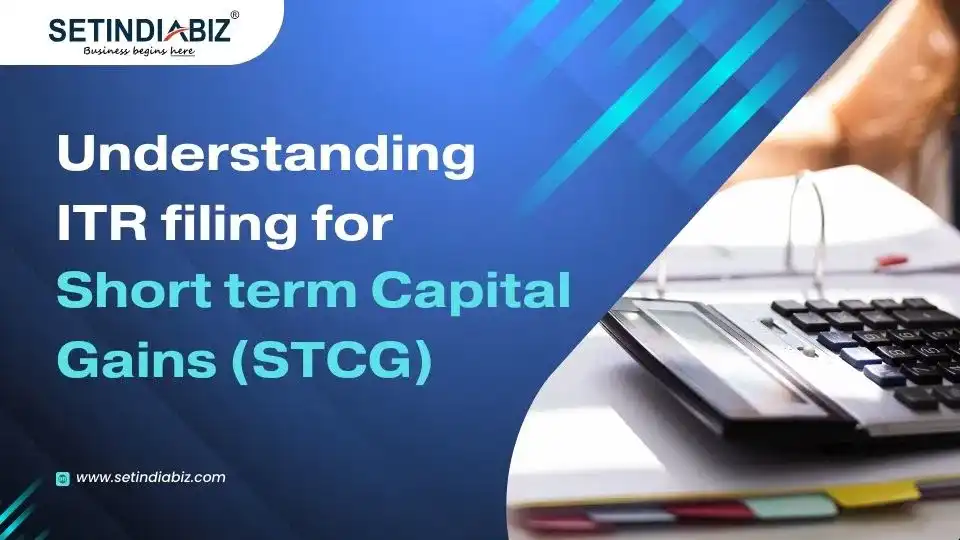How to filing ITR for short term capital gain?
Overview : Income Tax Return (ITR) is a necessary annual compliance that taxpayers or businesses need to file each financial year. However, choosing the appropriate ITR form is necessary as per the nature of the income & its source. If you are a salaried individual whose revenue also comes in the form of capital gains, you need to file ITR for Capital Gains. Get to know about the stepwise process of filing short term capital gain ITR Form for short-term capital India with this blog post.
Understanding ITR filing for Short term Capital Gains (STCG)
As a taxpayer, you must understand which ITR form is suitable for you; especially in case you have multiple income sources. In general, almost 7 ITR Forms are there in India to file different kinds of tax returns. As per the nature of income earned the previous year, the selection of the right or appropriate form is necessary accordingly.

If you are an individual taxpayer and earn capital gains/losses during the financial year, you can file it using Form ITR-2 and ITR-3. Any salaried person who is eligible to file a return using ITR 1 Form, will be needed to file ITR-2 to report the capital gains.
On the other hand, a taxpayer has to file Form ITR 3 if he makes earnings from a business or profession. Be it long-term or short-term capital gains, ITR 2 Form needs to be filed.
What is Short-term Capital Gain?
If you are also not sure about ‘what is short term capital gain?’ No worries, we’ll explain it to you! Short-term capital gain refers to any capital gain/profit that you earn by the sale of short-term capital assets. Now, you would be wondering what are the short-term capital assets? Let’s simplify it for you!
Short-term capital assets are the assets which are owned by a taxpayer for less than 36 months from the date of its purchase. However, this time period has been set to 12 months in the case of assets like shares listed on recognized stock exchanges in the country.
A taxpayer will have to file ITR for short term capital gain tax on property, provided the property transfer happens within 3 years of ownership/purchase. However, gains or profits from the sale of equity shares listed on stock exchanges after holding for less than 12 months are considered short-term capital gains.
The tax applicable on short-term capital gains is fixed by the Government of India which comes under Section 111A of the Income Tax Act. The current tax rate on short-term capital gains is 15% minus surcharge and cess which are unnecessary or you can say ‘extra. STCG that don’t fall under section 111A, fall under the category of Normal short-term capital gains and are charged taxes as per the total taxable income of a particular individual. The process of filing short term capital gain ITR Form is covered in the further section.
Process to file ITR 2 for Short term Capital Gains
Individuals and HUF earning profits/damages from stock purchases and sales or by selling any short term assets are needed to file Form ITR-2. By following the steps mentioned below, you can have your ITR filing for short term capital gain completed properly;
Step 1: Go to the official online portal of the Income Tax Department and log in with the valid credentials.
Step 2: Explore e-File>Income Tax Returns>File Income Tax Returns.
Step 3: After that a taxpayer must select the assessment year, choose the status, and then type of form. After that, select ‘Taxable income is more than basic exemption’ which is your reason for filing ITR for short term capital gains.
Step 4: On the further page, you will see 5 different types of schedules. After that, select ‘General’ and click on ‘Income Schedule’. Then tap on ‘Schedule Capital Gains’ and choose your capital assets type from the given list.
Step 5: In order to report STCG, click on ‘Add details’. After that, you have to enter the consolidated amount which is received from the sale of short-term assets, and also the Cost of Acquisition (COA) in a particular FY.
Step 6: When the required schedules are ‘Confirmed’, you have to review Part B TTI and then click on the ‘Preview Return’ option. Now, they have to download the ITR and proceed with the declaration.
Step 7: Finally, you will have to enter specific details as instructed and tap on ‘Proceed to Validation’. Post validation, verify your ITR Filing for short term capital gains. The verification process can be completed either electronically or by sending a signed ITR-V printout to the Income Tax Department office located in Bangalore.
As a taxpayer, if you want to do ITR filing for short-term capital gain, follow the above-mentioned steps. While filing ITR for capital gains, it’s important to enter correct and accurate data in each section and also verify them before final submission of the short term gain ITR Form.